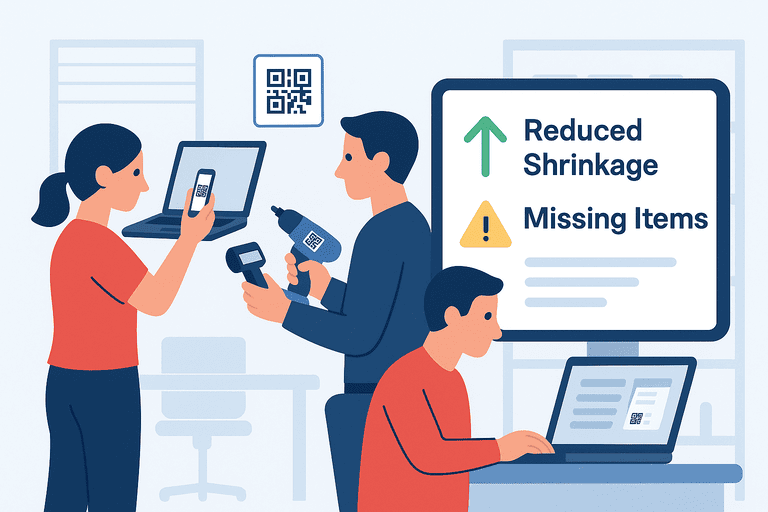Reducing Shrinkage and Loss with Smart Inventory Tools
Learn how smart inventory tools reduce shrinkage and loss, helping businesses save money, improve accountability, and boost efficiency.

Introduction
Shrinkage — the gap between recorded inventory and what actually exists — is one of the biggest hidden costs for businesses. It includes theft, misplacement, damage, and human error.
For retailers, shrinkage can reach 2–3% of sales, while for offices, warehouses, and coworking spaces, it results in missing laptops, tools, or supplies. Over time, these losses seriously erode profitability.
The good news? Smart inventory tools like QR codes, mobile apps, and digital dashboards can dramatically reduce shrinkage and loss. This article explores how they work and the best practices to put them into action.
What Is Inventory Shrinkage?
Inventory shrinkage happens when the actual quantity of assets or stock doesn’t match the recorded numbers in your system.
Common causes include:
- Theft — employee or external theft of valuable items.
- Human error — incorrect counts or misplaced items.
- Damage — assets broken without documentation.
- Unrecorded usage — items borrowed or consumed but never logged.
Why Shrinkage Hurts Businesses
Shrinkage doesn’t just affect stock levels — it creates ripple effects:
- Direct financial loss — stolen laptops or supplies must be replaced.
- Higher insurance premiums — frequent claims raise costs.
- Lost productivity — staff waste time searching for missing items.
- Compliance risks — audits fail when records don’t match reality.
Even a few percentage points of shrinkage can turn profits into losses.
How Smart Inventory Tools Reduce Shrinkage
1. QR Codes and Barcodes
- Tag every item with a unique identifier.
- Staff scan items when checking in/out.
- Prevents untracked borrowing or “vanishing” equipment.
2. Mobile Scanning Apps
- Employees use smartphones to log asset movement instantly.
- Reduces reliance on paper logs that often get skipped.
3. Digital Dashboards
- Centralized view of all assets.
- Managers spot anomalies quickly (e.g., 10 monitors purchased, only 8 in use).
4. Automated Alerts
- Notifications for overdue returns.
- Low-stock alerts prevent shortages that encourage “borrowing.”
5. Audit & Reporting Tools
- Regular digital audits highlight discrepancies.
- Reports identify loss trends, such as frequent shortages in specific departments.
Step-by-Step: Implementing Smart Inventory Tools
Step 1: Label All Assets
- Apply QR codes or barcodes to every item — laptops, monitors, tools, supplies.
- Use durable labels for heavy-use items.
Step 2: Create a Digital Register
- Import data into inventory software like InvyMate.
- Include purchase date, category, and assigned user.
Step 3: Train Staff
- Make scanning part of everyday processes.
- Explain how it improves fairness and reduces blame.
Step 4: Run Regular Audits
- Monthly spot checks.
- Quarterly full audits using mobile scanning apps.
Step 5: Monitor Reports
- Identify patterns: which items frequently go missing?
- Adjust policies or stock levels accordingly.
Example: Shrinkage in a Coworking Space
A coworking space with 120 members constantly lost HDMI cables, monitors, and chairs. Annual replacement costs reached $15,000.
After adopting asset management system with QR-code tracking:
- Every item was labeled and logged.
- Members scanned electronics when borrowing.
- Missing items dropped by 70% in the first year.
- Savings paid for the system within 3 months.
👉 Read more about tracking shared equipment in our guide: How Coworking Spaces Can Track Furniture, Electronics, and Supplies.
Best Practices for Reducing Shrinkage
- Tag every item, even “small” ones like cables and chargers.
- Automate check-in/out to reduce human error.
- Run regular digital audits and reconcile records.
- Set accountability rules (e.g., overdue alerts for borrowed tools).
- Use data reports to identify problem areas.
- Train staff and members to build a culture of responsibility.
Common Mistakes to Avoid
- Only tagging expensive items — small, frequent losses add up.
- Relying on spreadsheets — prone to errors and delays.
- Skipping audits — shrinkage grows unnoticed.
- No clear policies — staff ignore systems if rules aren’t enforced.
Conclusion
Shrinkage is one of the silent killers of profitability. Whether you run a retail store, office, or coworking space, missing assets and supplies drain money every year.
By using smart inventory tools — QR codes, mobile apps, and automated dashboards — businesses can reduce theft, increase accountability, and save significant costs.
👉 Ready to reduce shrinkage and protect your assets? Try InvyMate today — the QR-powered inventory tool designed to cut losses and boost efficiency.